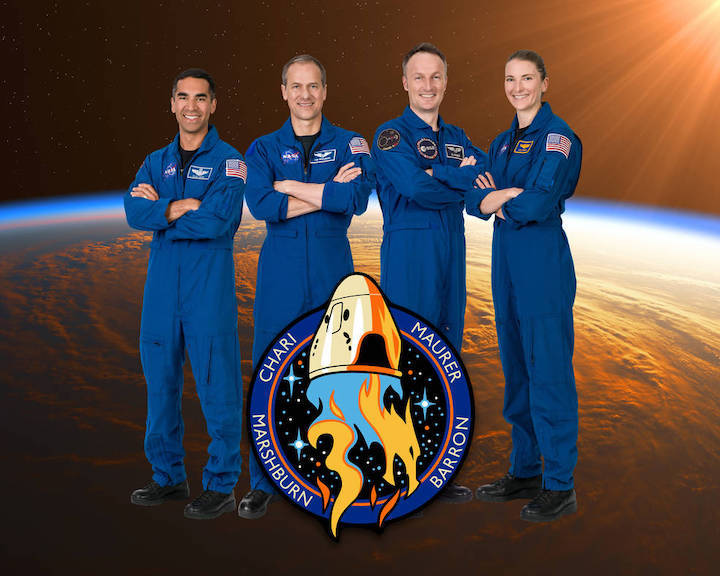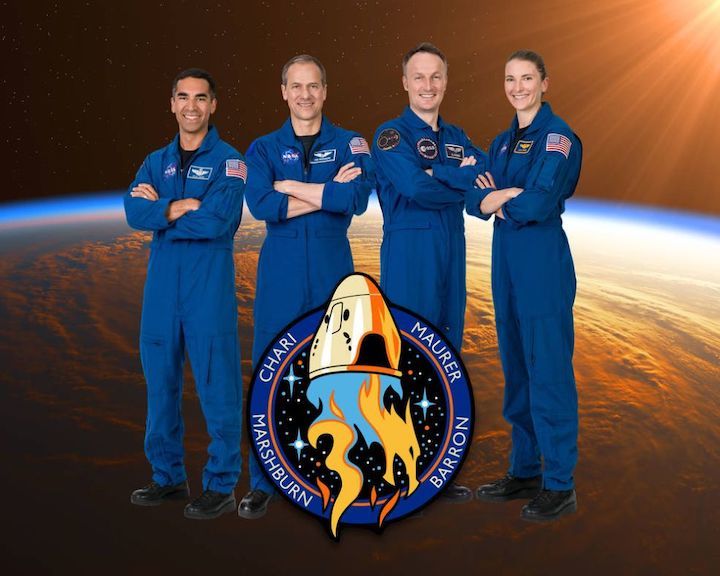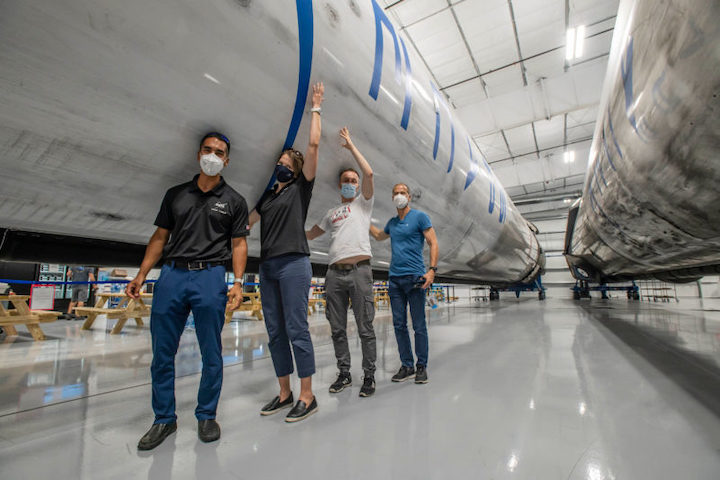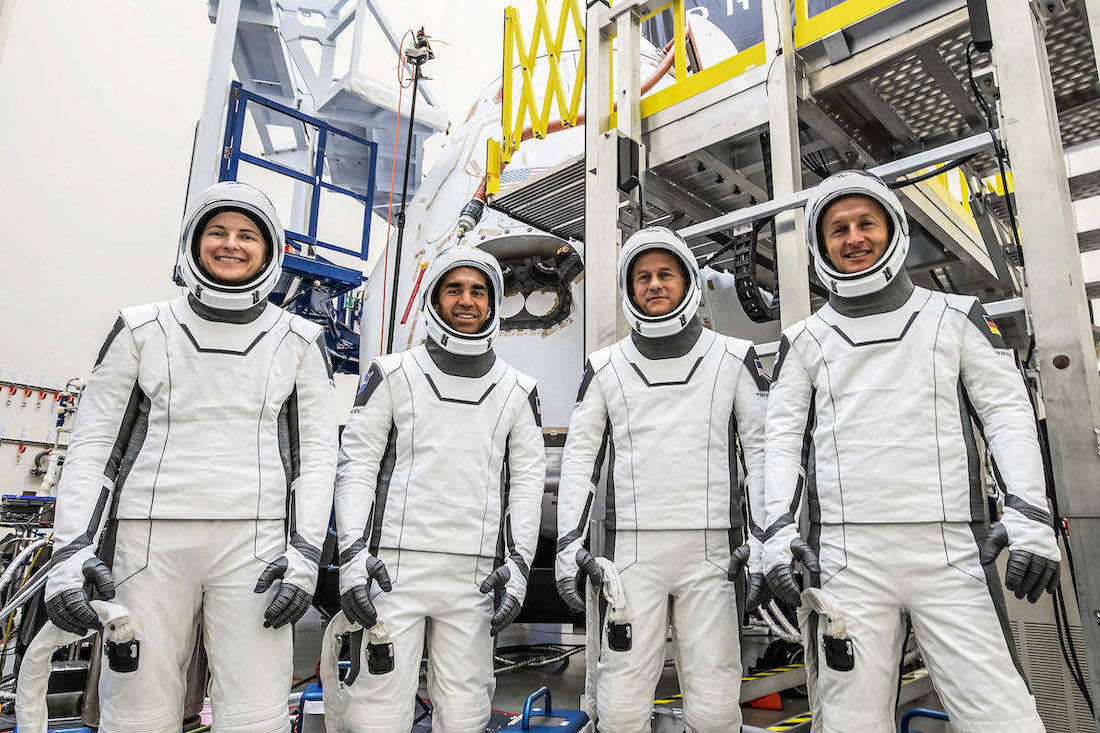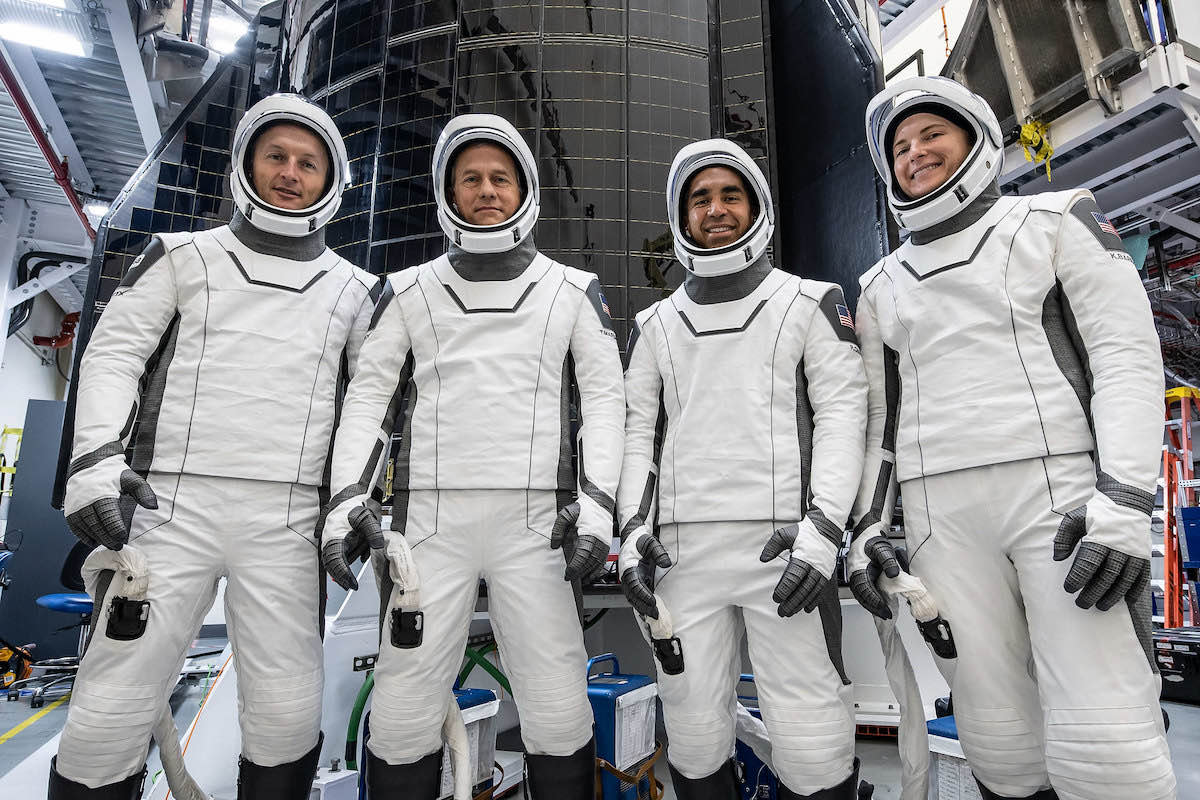16.12.2020
NASA, ESA Choose Astronauts for SpaceX Crew-3 Mission to Space Station

NASA and ESA (European Space Agency) have selected three astronauts to serve as crew members for NASA’s SpaceX Crew-3 mission to the International Space Station, which is expected to launch in the fall of 2021.
The trio will consist of NASA astronauts Raja Chari and Tom Marshburn, who will serve as commander and pilot, respectively, and ESA astronaut Matthias Maurer, who will serve as a mission specialist. A fourth crew member will be added at a later date, following a review by NASA and its international partners.
This will be the first spaceflight for Chari, who became a NASA astronaut in 2017. He was born in Milwaukee, but considers Cedar Falls, Iowa, his hometown. He is a colonel in the U.S. Air Force and joins the mission with extensive experience as a test pilot. He has accumulated more than 2,500 hours of flight time in his career. Chari was selected earlier this month as a member of the Artemis Team and is now eligible for assignment to a future lunar mission.
Marshburn is a Statesville, North Carolina, native who became an astronaut in 2004. Prior to serving in the astronaut corps, the medical doctor served as flight surgeon at NASA’s Johnson Space Center in Houston and later became medical operations lead for the International Space Station. The Crew-3 mission will be his third visit to the space station and his second long-duration mission. Marshburn previously served as a crew member of STS-127 in 2009 and Expedition 34/35, which concluded in 2013.
Maurer comes from Sankt Wendel, in the German state of Saarland. Like Chari, Maurer will be making his first trip to space with the Crew-3 mission. Before becoming an astronaut, Maurer held a number of engineering and research roles, both in a university setting and at ESA. In 2016, Maurer spent 16 days on an undersea mission as part of a NASA’s Extreme Environment Mission Operations, or NEEMO, space analog.
When Chari, Marshburn, and Maurer arrive at the orbiting laboratory, they will become expedition crew members for the duration of their six-month stay. The crew will have a slight overlap with the Crew-2 astronauts, who are expected to launch in the spring of 2021. This will not be the first commercial crew mission to overlap. The Crew-1 astronauts, who are currently on station, and the Crew-2 astronauts, also are expected to coincide in their sojourns for a short time. Increasing the total number of astronauts aboard the station is allowing the agency to boost the number of science investigations conducted in the unique microgravity environment.
This will be the third crew rotation mission of SpaceX’s human space transportation system and its fourth flight with astronauts, including the Demo-2 test flight, to the space station through NASA’s Commercial Crew Program. The goal of the program is to provide safe, reliable, and cost-effective crew access to the space station and low-Earth orbit in partnership with American aerospace industry. NASA’s contract with SpaceX is for six total crew missions to the orbiting laboratory. Commercial transportation to and from the station will provide expanded utility, additional research time, and broader opportunities for discovery on the orbital outpost.
For more than 20 years, humans have lived and worked continuously aboard the International Space Station, advancing scientific knowledge and demonstrating new technologies, making research breakthroughs not possible on Earth. As a global endeavor, 242 people from 19 countries have visited the unique microgravity laboratory that has hosted more than 3,000 research and educational investigations from researchers in 108 countries and areas.
The station is a critical test bed for NASA to understand and overcome the challenges of long-duration spaceflight. As commercial companies focus on providing human transportation services to and from low-Earth orbit, NASA is free to focus on building spacecraft and rockets for deep space missions to the Moon and Mars.
Quelle: NASA
+++
NASA assigns astronauts for third SpaceX commercial crew mission
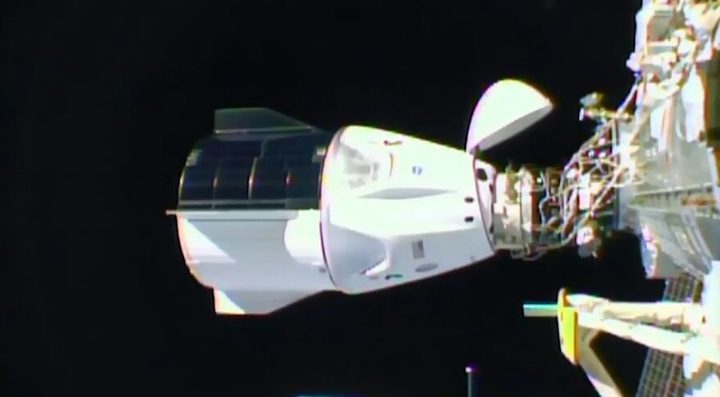
WASHINGTON — NASA has selected three astronauts for a future SpaceX commercial crew mission to the International Space Station as it leaves open the possibility of exchanging seats with Russia.
NASA and the European Space Agency jointly announced Dec. 14 they had assigned NASA astronauts Raja Chari and Tom Marshburn and ESA astronaut Matthias Maurer to the SpaceX Crew-3 mission. That commercial crew mission is scheduled for launch in the fall of 2021.
Chari, who will serve as commander of the mission, joined the astronaut corps in 2017 and will be making his first spaceflight. He is also part of NASA’s “Artemis Team” of astronauts announced Dec. 9 who are eligible for future Artemis lunar missions. Marshburn, a NASA astronaut since 2004, flew on the STS-127 shuttle mission in 2009 and spent nearly five months on the ISS in 2012 and 2013. Maurer, who joined ESA’s astronaut corps in 2015, will be making his first spaceflight.
The agencies did not announce who will occupy the fourth seat on the Crew Dragon spacecraft for this mission. “A fourth crew member will be added at a later date, following a review by NASA and its international partners,” NASA stated in a release about the crew assignments.
So far, only astronauts from NASA, ESA and the Japanese space agency JAXA have been assigned to commercial crew missions. The Crew-1 mission currently at the ISS includes three NASA astronauts and one JAXA astronaut, while the Crew-2 mission expected to launch in the spring of 2021 will fly two NASA astronauts and one each from ESA and JAXA.
NASA, however, has expressed its interest in what it calls “mixed crews,” flying Russian cosmonauts on commercial crew vehicles in exchange for allowing NASA astronauts to fly on Soyuz spacecraft. Those exchanges, done on a bartering basis, would ensure there is at least one NASA and one Roscosmos astronaut on the ISS should either the Soyuz or commercial crew vehicles be out of service for a time.
Roscosmos, though, has been skeptical about flying its cosmonauts on commercial crew missions. At a March meeting of the ISS Advisory Committee, former astronaut Tom Stafford, chair of the committee, said Russian officials would consider flying cosmonauts on commercial crew vehicles eventually, but would not fly on the first missions of those spacecraft.
Discussions to enable mixed crews are ongoing. “We’re looking to fly on each other’s vehicles, probably later in 2021,” said Joel Montalbano, NASA ISS program manager, at a Nov. 13 briefing about the Crew-1 mission, which launched two days later. The first step for doing so, he said, is a government-to-government “implementing agreement” that was being drafted at the time of the briefing.
The launch of Crew-3 will overlap with Crew-2, just as Crew-2 will overlap with Crew-1, NASA said. That means that the first operational mission by Boeing’s CST-100 Starliner commercial crew vehicle, called Starliner-1, will likely be delayed until at least the spring of 2022. NASA announced in August it had selected astronaut Jeanette Epps for that mission, joining Sunita Williams and Josh Cassada, who had been assigned to the flight in 2018.
At the time of the announcement, NASA said that Starliner-1 would launch by the end of 2021, but did not give a more precise date. The agency said Dec. 9 that a second uncrewed test flight of the spacecraft, called Orbital Flight Test 2, had been scheduled for March 29. That will be followed by a crewed test flight with three NASA astronauts on board in the summer of 2021.
Quelle: SN
+++
ESA astronaut Matthias Maurer officially assigned first flight

ESA astronaut Matthias Maurer has been assigned to his first flight to the International Space Station during a meeting of representatives from the US, Russian, Japanese, Canadian and European space agencies at the beginning of December.
Matthias’ mission is expected to begin in autumn 2021. He will be the second ESA astronaut to fly under NASA’s Commercial Crew Programme and is expected to be launched from the agency’s Kennedy Space Center in Florida, USA, as part of SpaceX Crew-3, along with NASA astronauts Raja Chari and Thomas H. Marshburn.
The mission will see the German ESA astronaut live and work in orbit for roughly six months, carrying out science and operations on behalf of researchers and international partners worldwide.
One year, two flights
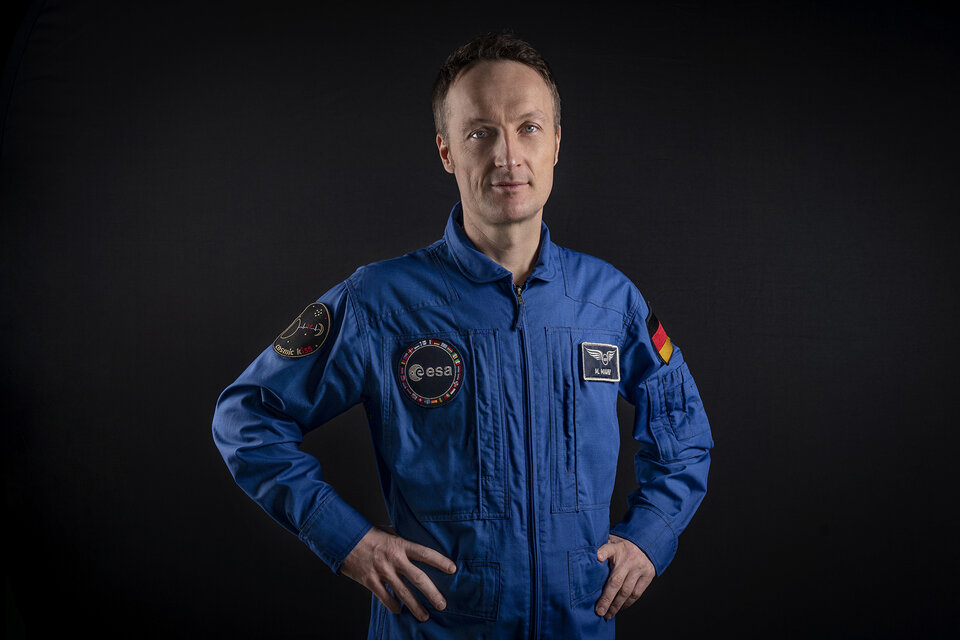
ESA Director General Jan Wörner looks forward to Matthias’ first mission and says the Space Station is a shining symbol of what can be achieved when nations from around the world work together.
“The work we do on the International Space Station helps improve life on Earth as we go forward to the Moon,” he says.
“Two European missions in 2021 will enable us to carry out even more vital science and research in collaboration with our international partners. I’m delighted to see this great collaboration continuing more than 20 years after the first crew was launched.”
Matthias officially joined ESA’s Astronaut Corps in 2015 and is the only ESA astronaut yet to fly to space. ESA Director of Human and Robotic Exploration David Parker says his flight, and the second flight of ESA astronaut Thomas Pesquet before him, stands testament to a strong commitment to European space exploration shown by Member States in context of ESA’s Space19+ ministerial conference in 2019.
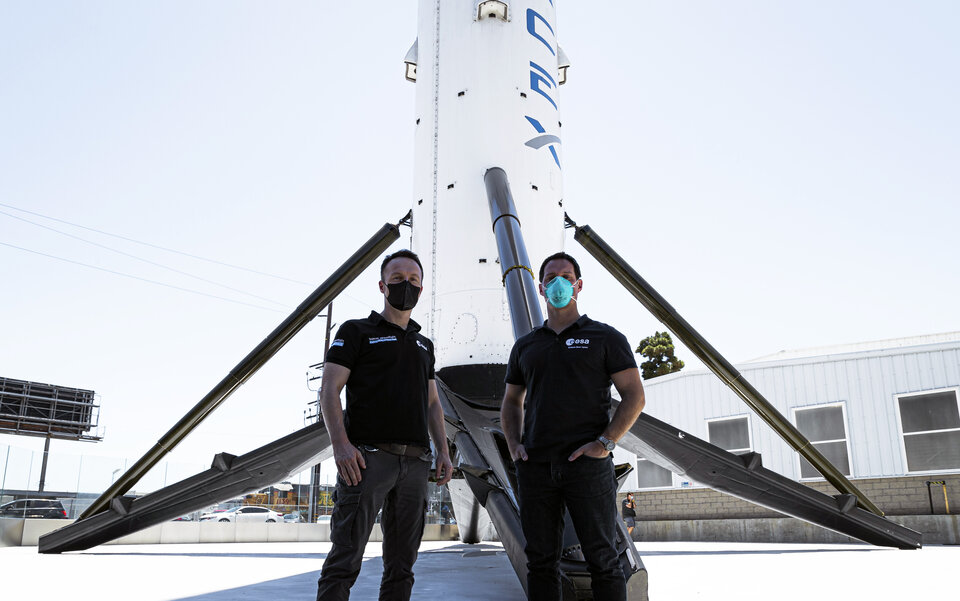
“With a 30% increase in annual investment we are able to continue European flights to the Space Station at the rate of at least one per year, ensuring Europe is well represented in space.
“The recent Memorandum of Understanding with NASA also provides three opportunities for European astronauts to fly to a new lunar outpost known as the Gateway, where they will live and work in orbit around the Moon for the first time. We are entering an exciting new era for space exploration in which Europe will play a key role.”
A declaration of love for space
Alongside his official assignment, Matthias Maurer also revealed the name of his first space mission: Cosmic Kiss. He describes this carefully selected mission name as a 'declaration of love for space'.
“It communicates the special connection the Station provides between Earth’s inhabitants and the cosmos,” explains Matthias. “It also conveys the value of partnership in exploring farther to the Moon and Mars, alongside the need to respect, protect and preserve the nature of our home planet as we seek a sustainable future on Earth.”
“I look forward to building on the curiosity and knowledge of those who went before me, and sharing my own experiences as an ambassador for Europe in orbit,” he adds.
Creating the perfect patch
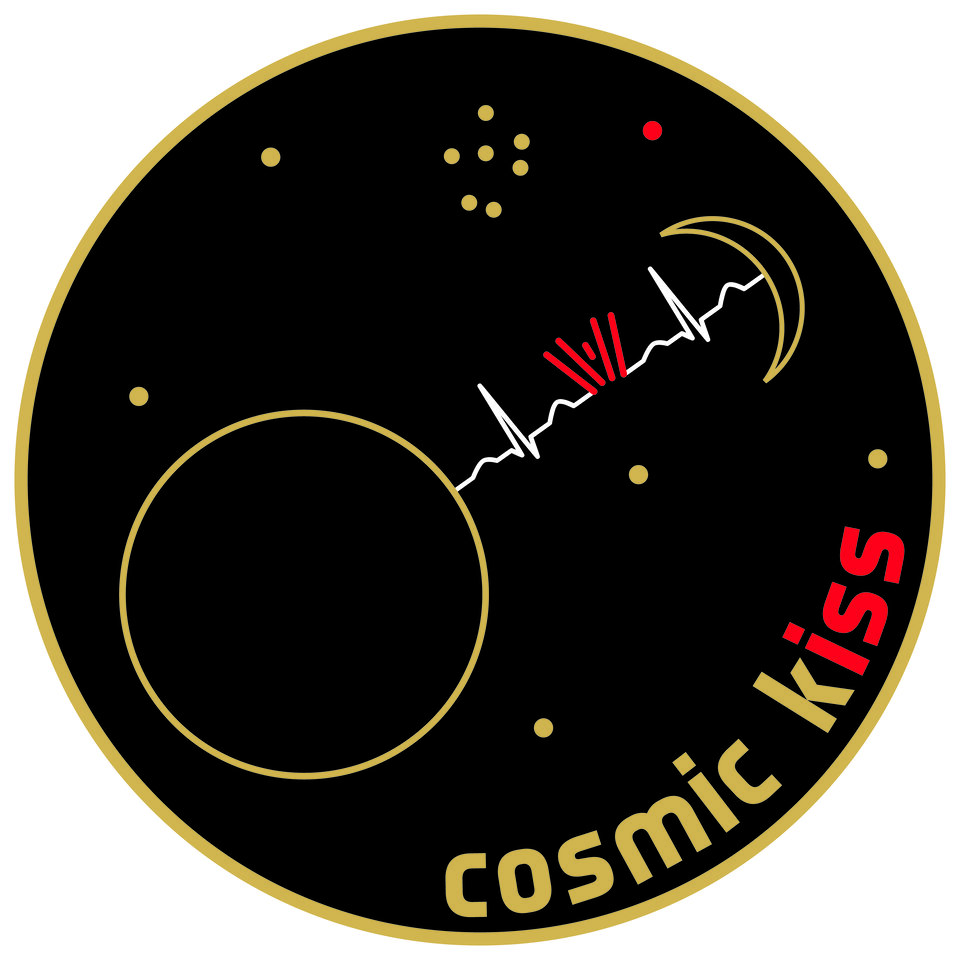
In developing the Cosmic Kiss mission patch, Matthias took inspiration from the Nebra sky disc ('Himmelsscheibe von Nebra') – the oldest known realistic illustration of the night sky – as well as the Pioneer plaques and Voyager Golden Records that were sent on spaceprobes into the unknown carrying messages from Earth.
“These artefacts show a fascination with space that spans the ages. Since the beginning of time, humans have looked skyward for knowledge about the origins of life, the Universe,” he says.
The mission patch features several cosmic elements including Earth, the Moon and the Pleiades star cluster. It also depicts Mars, one of ESA’s three key destinations for exploration over the next 10 years, as a small red dot beckoning in the distance. However, its most prominent feature is a simplified, almost heart-like International Space Station, connected through a human heartbeat that stretches from Earth to the Moon.
About Matthias

Originally from the southwest German state of Saarland, Matthias has studied in four different countries, gained a doctorate in materials science engineering and achieved national recognition for outstanding research.
In 2016 he participated in the NASA NEEMO 21 analogue mission, spending a total of 16 days underwater as part of a crew testing exploration strategies and tools for future Mars missions. He has participated in sea survival training off the coast of China with fellow ESA astronaut Samantha Cristoforetti and seven Chinese Taikonauts. He has also taken part in several geological field training exercises related to future lunar exploration.
Before his assignment, Matthias was based at ESA’s European Astronaut Centre in Cologne, Germany, where he was project managing the development of ESA’s future Luna Moon simulation facility.
He is passionate about the opportunity to combine a love of science and technology with international collaboration and adventure, and looks forward to sharing a taste of his home region while in orbit following a recent competition to select a Saarland dish for space.
Quelle: ESA
----
Update: 19.05.2021
.
Kayla Barron Joins NASA’s SpaceX Crew-3 Mission to Space Station
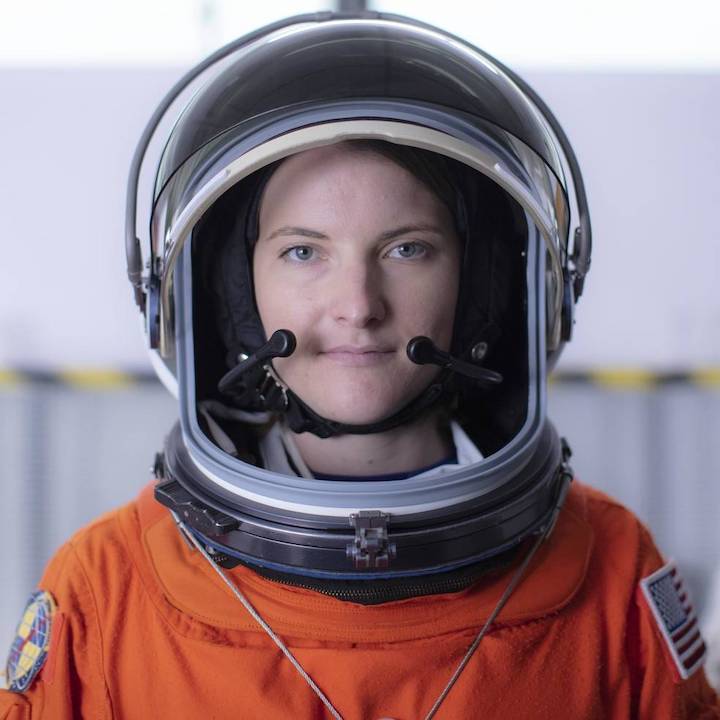
NASA has assigned Kayla Barron to serve as a mission specialist for the agency’s SpaceX Crew-3 mission to the International Space Station, which is targeted to launch as early as Oct. 23.
This will be the first spaceflight for Barron, who became a NASA astronaut in January 2020 after completing two years of training. She will join NASA astronauts Raja Chari and Tom Marshburn, as the mission’s commander and pilot, respectively, and ESA (European Space Agency) astronaut Matthias Maurer, who also will serve as a mission specialist.
This will be the third crew rotation mission on SpaceX’s human space transportation system and its fourth flight with astronauts, including the Demo-2 test flight, to the space station through NASA’s Commercial Crew Program.
Barron was born in Pocatello, Idaho, but considers Richland, Washington, her hometown. She earned a bachelor’s degree in systems engineering from the U.S. Naval Academy in Annapolis, Maryland, in 2010. She earned a master’s degree in nuclear engineering from the University of Cambridge, in England, in 2011, as Gates Cambridge Scholar. Lt. Cmdr. Barron earned her submarine warfare officer qualification and deployed three times while serving aboard the USS Maine. At the time of her selection as an astronaut candidate in 2017, she was serving as the flag aide to the superintendent of the U.S. Naval Academy.
NASA previously assigned Chari, Marshburn, and Maurer to the mission in December 2020. This will be the first spaceflight for Chari and Maurer. It will be the third spaceflight for Marshburn, who previously served as a crew member of the space shuttle STS-127 mission in 2009 and Expedition 34/35 aboard the space station, which concluded in 2013.
When Barron, Chari, Marshburn, and Maurer arrive at the orbiting laboratory, they will become expedition crew members for the duration of their six-month science mission. The crew will have a slight overlap with the Crew-2 astronauts, who arrived April 24. This will mark the second time commercial crew missions have overlapped on the station. The Crew-1 astronauts, who ended their mission with a splashdown off the coast of Panama City, Florida, on Sunday, May 2, were aboard the station with the Crew-2 astronauts for a seven-day direct crew handover. Increasing the total number of astronauts aboard the station enables the agency to boost the number of science investigations conducted in the unique microgravity environment.
Quelle: NASA
+++
NASA adds astronaut to commercial crew mission
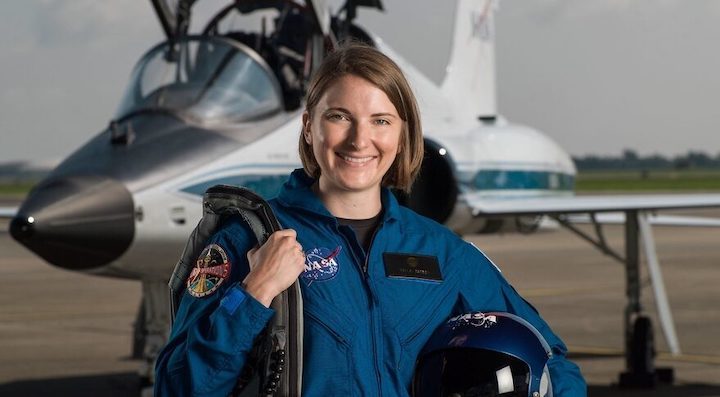
WASHINGTON — NASA announced May 17 it has assigned another astronaut to the next commercial crew mission to the International Space Station, a sign that NASA no longer expects to complete a seat barter agreement with Roscosmos in time for that flight.
NASA said that Kayla Barron will join the Crew-3 mission, launching on a SpaceX Crew Dragon spacecraft scheduled for launch no earlier than Oct. 23. Barron joins NASA astronauts Raja Chari and Tom Marshburn, and European Space Agency astronaut Matthias Maurer, who had been assigned to Crew-3 last December.
The Crew-3 mission will relieve the Crew-2 astronauts who arrived at the station on another Crew Dragon spacecraft April 24. The four Crew-3 astronauts will remain on the station for a six-month stay.
Barron, like Chari and Maurer, is a rookie astronaut. A naval officer, she was selected in the 2017 NASA astronaut class, which also included Chari. Marshburn, by contrast, will be making his third flight to space, having flown on the STS-127 shuttle mission in 2009 and later spending five months on the ISS as part of the Expedition 34/35 crew in 2012–2013.
Barron’s addition to the crew was not a surprise. Images of the SpaceX crew patch for the mission, posted on the website collectSPACE May 3, showed Barron’s name along with the three other astronauts previously assigned to the mission. A biography of Barron on the agency’s website also briefly stated around that time that she had been assigned to Crew-3.
NASA had kept the fourth seat on Crew-3 open for months in the hopes that it could be assigned to a Russian cosmonaut as part of a seat barter agreement. Under such an agreement, NASA astronauts would continue to fly on Soyuz seats in exchange for Roscosmos cosmonauts flying on commercial crew vehicles. Such “mixed crews” would ensure there is always at least one cosmonaut and one astronaut on the station at any time should either Soyuz or commercial crew vehicles be unavailable for an extended period.
By April, though, it appeared unlikely that an agreement between NASA and Roscosmos could be concluded in time for a cosmonaut to be assigned to and train for Crew-3. “We haven’t completely given up on having a cosmonaut on Crew-3, but at this point, given the schedule, it would be really, really challenging to complete all the training and get the suit fitted and done for a cosmonaut on Crew-3,” Steve Jurczyk, at the time NASA acting administrator, said at an April 21 briefing at the Kennedy Space Center ahead of the Crew-2 launch.
One factor that reduces the urgency for completing a seat barter agreement is Russia’s plans for upcoming Soyuz flights. NASA astronaut Mark Vande Hei, who flew to the station in April on a Soyuz spacecraft using a seat acquired through a third party, Axiom Space, would ordinarily return home in October. However, Roscosmos will fly a film director and actress to the station on the next Soyuz mission in October, the agency confirmed May 13, which means that Vande Hei and Russian cosmonaut Pyotr Dubrov will remain on the station, perhaps until April 2022.
“We’ll work through whether there’s an opportunity for Mark to extend to a year, or if we need to do something else to ensure that we have crew” on the U.S. segment of the station, Jurczyk said at that briefing.
Quelle: SN
+++

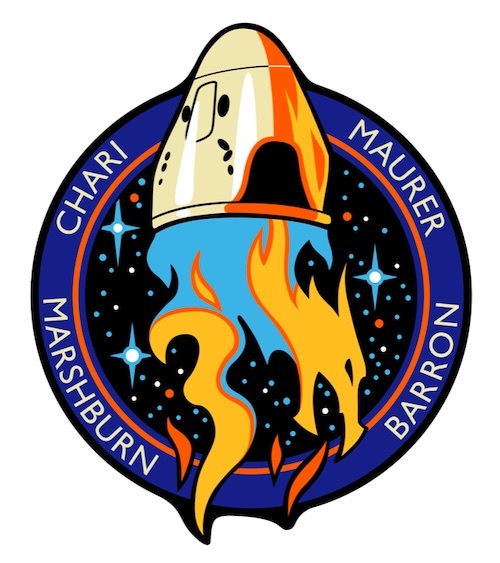
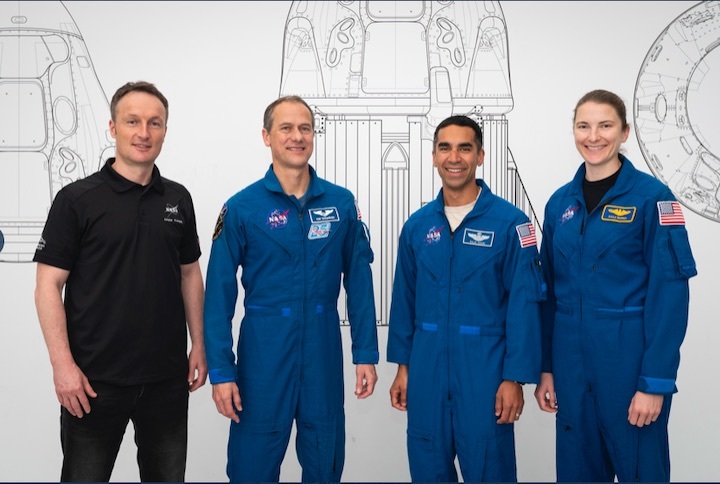
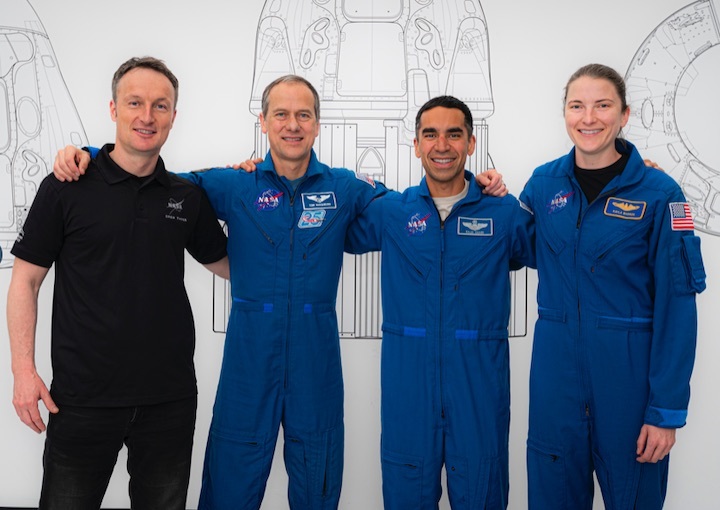
Quelle: Twitter
----
Update: 22.05.2021
.
NASA will host a media teleconference at 1 p.m. EDT Wednesday, May 26, to discuss select science investigations launching on the next SpaceX commercial resupply flight to the International Space Station. From research on water bears that could help understand human stress factors in space to testing ultrasound technologies for medical use on future deep space missions, the launch will deliver experiments to benefit people on and off the Earth.
Audio of the teleconference will stream live online at:
SpaceX is targeting 1:29 p.m. Thursday, June 3, for the launch of its Dragon spacecraft on a Falcon 9 rocket from Launch Complex 39A at NASA’s Kennedy Space Center in Florida. This will be SpaceX’s 22nd Commercial Resupply Services mission and the second cargo resupply mission on the company’s upgraded version of its Dragon spacecraft.
To participate in the teleconference, media must contact Kathryn Hambleton at: kathryn.hambleton@nasa.gov by 11 a.m. Wednesday, May 26, for dial-in information.
Participants in the briefing will be:
- Jennifer Buchli, deputy chief scientist for NASA’s International Space Station Program Science Office, who will share an overview of the research being conducted aboard the space station and how it benefits exploration and humanity
- Dr. Thomas Boothby, assistant professor of molecular biology at the University of Wyoming and principal investigator for Cell Science-04, which will examine how tardigrades – commonly called water bears – adapt to conditions in low-Earth orbit, which could advance understanding of the stress factors affecting humans in space
- Dr. Jamie Foster, professor in the Department of Microbiology and Cell Science at the University of Florida and principal investigator for the ADSEP-UMAMI investigation, which will study bobtail squid as a model to examine the effects of spaceflight on interactions between beneficial microbes and their animal hosts
- Dr. Jonathan Himmelfarb, principal investigator for the Kidney Cells-02 tissue chip experiment, which could help develop better pharmaceuticals and therapies for treating kidney disease on Earth
- Kadambari Suri, integration manager for the Butterfly IQ Technology demonstration, which will test a portable ultrasound technology that could provide important medical capabilities for future exploration missions beyond low-Earth orbit
- Maurice Marnat, payload manager and system engineer at the Centre national d'études spatiales, who will discuss Pilote, a technology demonstration testing the effectiveness of remotely operating robotic arms and space vehicles, using virtual reality and haptics interfaces
SpaceX’s Dragon spacecraft also will carry crew supplies and hardware to the orbiting laboratory to support the Expedition 65 and 66 crew.
The space station is a convergence of science, technology, and human innovation that demonstrates new technologies and enables research not possible on Earth, and has been occupied continuously since November 2000. In that time, 242 people, as well as a variety of international and commercial spacecraft, have visited the orbiting laboratory. The space station remains the springboard to NASA's next great leap in exploration, including future human missions to the Moon and eventually to Mars.
Quelle: NASA
----
Update: 26.05.2021
.
NASA assigns fourth astronaut to SpaceX’s next space station crew launch

NASA has assigned astronaut Kayla Barron to join three crewmates on a SpaceX Dragon spacecraft set to launch to the International Space Station in October, rounding out a four-person team after the space agency was unable to secure an agreement to add a Russian cosmonaut to the mission.
Barron, a lieutenant commander in the U.S. Navy, will be launching on her first mission to space. She joins commander Raja Chari, another first-time space flier, veteran astronaut Thomas Marshburn, and rookie European Space Agency astronaut Matthias Maurer on SpaceX’s third operational Crew Dragon flight to the space station.
Chari, Marshburn, Maurer, and Barron will spend about six months on the orbiting research complex, replacing the Crew-2 astronauts who arrived at the station in April.
SpaceX is manufacturing a brand new reusable Crew Dragon spaceship for the Crew-3 mission, which is scheduled to launch aboard a Falcon 9 rocket Oct. 23 from pad 39A at NASA’s Kennedy Space Center in Florida.
NASA has contracted with SpaceX for at least six operational crew rotation flights to the space station, following an unpiloted Crew Dragon demonstration mission to the station in 2019 and a crew test flight in 2020.
The Crew-3 mission is the next SpaceX flight to carry astronauts to the space station, but SpaceX first plans to launch its first purely commercial Crew Dragon flight into orbit in September. That mission, named Inspiration4 at set to launch from Florida in September, will feature the first all-civilian crew on a three-day trip into low Earth orbit, without going to the International Space Station.
About a month later, the Crew-3 mission is scheduled to blast off.
NASA originally hoped to finalize an agreement with Roscosmos, the Russian space agency, to fly a Russian cosmonaut on the Crew-3 mission. But NASA officials said last month a draft of the agreement is still awaiting approval from the U.S. State Department, and time ran out to select and train a Russian cosmonaut for the mission launching in October.
NASA wants to sign an in-kind agreement with Roscosmos to fly Russian cosmonauts on U.S. crew missions and continue launching U.S. astronauts on Russian Soyuz flights to the space station. The no-funds-exchanged agreement would ensure at least one U.S. astronaut and one Russian cosmonaut are always aboard the outpost to operate crucial systems on the U.S. and Russian modules.
If a medical emergency or a hardware failure forced a premature ending to a space station expedition, the ISS could be left without personnel trained to oversee key parts of the complex.
NASA announced Chari, Marshburn, and Maurer’s assignment to the Crew-3 mission in December. The agency confirmed Barron’s participation in the mission in a statement May 17.
Barron and Chari will become the first members of NASA’s 2017 astronaut class to fly in space.
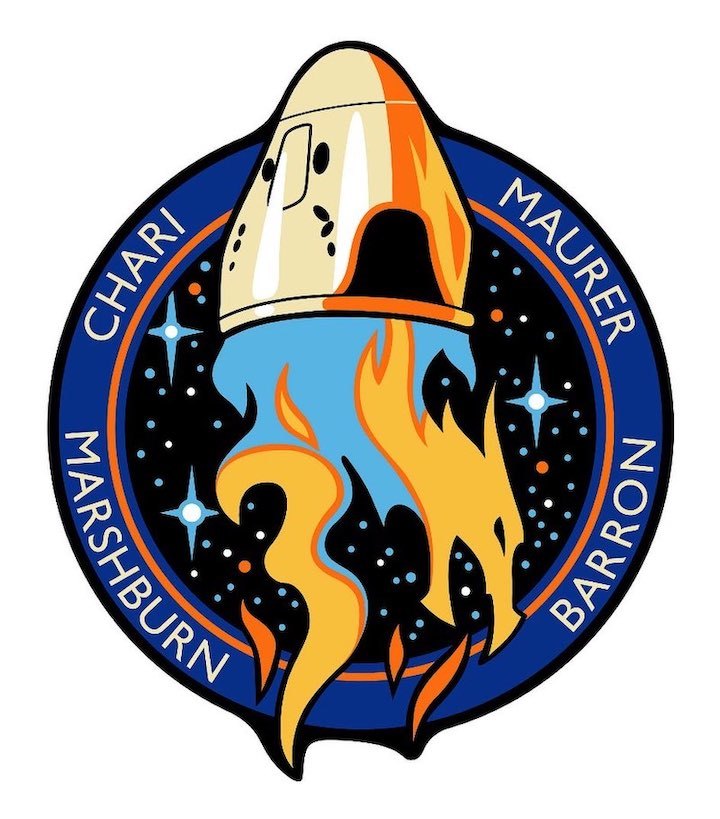
Chari, 43, is a colonel in the Air Force. He was born in Milwaukee and raised in Cedar Falls, Iowa, before earning a bachelor’s degree in aeronautical engineering from the U.S. Air Force Academy and a master’s degree in aeronautics and astronautics from the Massachusetts Institute of Technology.
Before his selection as a NASA astronaut in 2017, Chari flew F-15E combat missions in Operation Iraqi Freedom, graduated from the U.S. Naval Test Pilot School, and served as commander of the 461st Flight Test Squadron and director of the F-35 Integrated Test Force.
Marshburn, a 60-year-old medical doctor, will fly as pilot on the Crew-3 mission. He was born in Statesville, North Carolina, and graduated from Davidson College with a bachelor’s degree in physics and earned a master’s degree in physics from the University of Virginia.
Marshburn later graduated with a doctorate of medicine from Wake Forest University and master’s degree in medical science from the University of Texas Medical Branch. After working as an emergency physician, Marshburn joined NASA as a flight surgeon and supported astronauts flying on the Russian Mir space station, multiple space shuttle missions, and crews on the International Space Station.
NASA selected Marshburn as an astronaut in 2004, and he flew as a mission specialist aboard the space shuttle Endeavour on the STS-127 mission in July 2009. Marshburn’s second mission was a long-duration expedition on the International Space Station, during which he launched and landed on a Russian Soyuz spacecraft.
Marshburn has logged 161 days in space on his two previous missions.
European Space Agency astronaut Matthias Maurer, 51, will fly as a mission specialist on the Crew-3 mission.
Maurer is from Sankt Wendel in the German state of Saarland. ESA selected Maurer to join its astronauts corps in 2015. Before becoming an astronaut, Maurer graduated with a doctorate in materials science engineering from the Institute of Materials Sciences of the Technical University in Aachen, Germany, and began working at ESA in 2010 as a crew support engineer.
Barron, 33, was born in Pocatello, Idaho, but considers Richland, Washington, her hometown. She earned a bachelor’s degree in systems engineering from the U.S. Naval Academy and a master’s degree in nuclear engineering form the University of Cambridge.
She qualified as a submarine warfare officer and served on three patrols on a ballistic missile submarine before her selection as a NASA astronaut candidate in 2017.
Quelle: SN
----
Update: 12.09.2021
.
NASA Invites Media to Next SpaceX Commercial Crew Space Station Launch
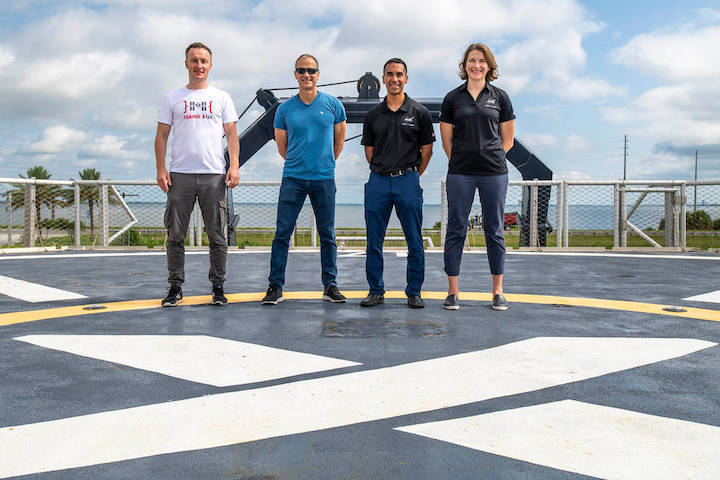
Media accreditation now is open for the launch of the third SpaceX Crew Dragon spacecraft and Falcon 9 rocket that will carry astronauts to the International Space Station for a long duration mission. This mission is part of NASA’s Commercial Crew Program.
The earliest targeted launch date for the agency’s SpaceX Crew-3 mission is Sunday, Oct. 31, from Launch Complex 39A at NASA’s Kennedy Space Center in Florida.
The launch will carry three NASA astronauts – mission commander Raja Chari, pilot Tom Marshburn, and mission specialist Kayla Barron to the space station – as well as ESA (European Space Agency) astronaut Matthias Maurer, who will serve as a mission specialist. This is the first spaceflight for Chari, Barron, and Maurer. It is the third for Marshburn. The crew will complete a six-month science mission aboard the microgravity laboratory in low-Earth orbit.
Astronauts from NASA’s SpaceX Crew-2 mission are scheduled for return in mid-November aboard the SpaceX Crew Dragon Endeavour on which they launched following a short crew handover period aboard the space station.
Media accreditation deadlines for Crew-3 are as follows:
- U.S. media and U.S. citizens representing international media must apply by 4 p.m. Sunday, Oct. 3.
- International media without U.S. citizenship must apply by 4 p.m. Sunday, Sept. 26.
All accreditation requests should be submitted online at:
NASA’s COVID-19 policies are updated as necessary and to remain consistent with guidelines issued by the Centers for Disease Control and Prevention and White House Safer Federal Workforce Taskforce. COVID-19 safety protocols for this event will be communicated closer to the date of the event. The agency also will communicate any updates that may impact mission planning or media access as necessary.
For questions about accreditation, please email ksc-media-accreditat@mail.nasa.gov.
For other questions, please contact Kennedy’s newsroom at 321-867-2468.
Para obtener información sobre cobertura en español en el Centro Espacial Kennedy o si desea solicitar entrevistas en español, comuníquese con Antonia Jaramillo 321-501-8425.
Quelle: NASA
----
Update: 15.09.2021
.



